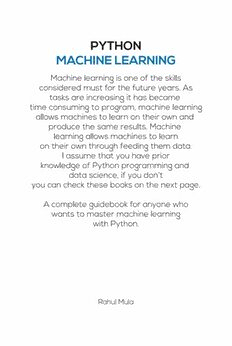
Machine Learning Made Easy Using Python PDF
Preview Machine Learning Made Easy Using Python
PYTHON MACHINE LEARNING Machine learning is one of the skills considered must for the future yeors. As tosks are increasing it has became time consuming to program, machine learning allows machines to learn on their own and produce the same results. Machine learning allows machines to learn on their own through feeding them data. I assume that you have prior knowledge of Python programming and data science, if you don't you can check these books on the next page. A complete guidebook for anyone who wants to master machine learning with Python. Rahul Mula Mochine Learning with Python by Rahul Mula © 2020 Machine Learning with Python All rights reserved. No portion of this book may be reproduced in any form without permission from the copyright holder, except as permitted by U.S. copyright law. Cover by Rahul Mula. All the programs written in this book are tested and verified by the author. Cover Template from freepik.com ISBN : 979-8-58-426755-1 /-----------------------------------------------------------------------------------------X MAKE SURE TO CHECK THEM OUT <_____________________________________________________> Python For Beginner A beginners guide to programming with python Data Science with Python Learn how to perform tasks like data processing, cleansing, analysis and visualization Why should you learn machine learning? or what are its uses? Would be the questions that may come to your mind. The answer is simple, think that you are given a data from a online store about its products and recommend products. The data has a product name, its category, its quantity, and rate columns with several hundred rows of products. If you want to perform some analysis like the product which is most purchased in that day, it will take a lot of time to do it manually. To ease up these tasks, we use data analysis, i.e. we run a program with codes to perform a certain data analysis. The computer runs the program and we get the output in just few seconds. Then we classify the user and suggest it products based on preferable categories on the basis of it's previous search results.So, How to do that? Well, we need to learn Data Science and Machine Learning to perform those tasks. Businesses S organizations are trying to deal with it by building intelligent systems using the concepts and methodologies from Data science, Data Mining and Machine learning. Among them, machine learning is the most exciting field of computer science. It would not be wrong if we call machine learning the application and science of algorithms that provides sense to the data. This book is prepared especially for beginners (at Data Science and Machine Learning), but you should be familiar with programming in Python. We will work with packages and modules like NumPy, SciPy, Pandas, Matplotlib, Scikit Learn, etc. to perform analysis and other tasks. I kept this book open to the basic concepts of data science to help the beginners to understand everything but the book only covers data science concepts prior for machine learning, as the name suggests, the book is not for you if you're looking for data science, you check the other books page to find that. I also included advanced topics to not limit you to the basics. Machine learning, algorithms, data science, etc. moy seem tough end boring, but as you handle more end more data, you'll ploy with it! ( ) contents PANDAS 1 03 • Features of Pandas Library CHAPTER pandas • Series • Data Frames MATPLOTLIB 1 06 • Features of matplotlib maltpMib . Data visualizationp CHAPTER • PyPlot in matplotlib ( ) contents SCIKIT LEARN 1 • Features of Scikit-learn library • How to work with data? CHAPTER k • Why use Python? 08 b? TYPES OF MACHINE LEARNING 1 • Supervised learning CH1 AAPPTTEERR O • Unsupervised learning k • Deep learning MATHEMATICS FOR MACHINE LEARNING 1 IDIID • Data instances I I I • Statistics CHAPTER k • Probability SCIKIT LEARN ALGORITHMS 1 • Regression algorithm CHAPTER • Classification algorithm • Clustering algorithm IMPORTING DATA I • Importing CSV data CHAPTER I I I I • Importing JSON data I • Importing Excel data r DDAATTAA OOPPEERRAATTIIOONNSS 1 • NNuummPPyy ooppeerraattiioonnss •• PPaannddaass ooppeerraattiioonnss CHAPTER •• CClleeaanniinngg ddaattaa V ( ) contents DATA ANALYSIS 8 PROCESSING 1 • Data analytics • Correlations between attributes CHAPTER k • Skewness of the data DATA VISUALIZATION 1 14 • Plotting data • Univaritae plots CHAPTER • Multivariate plots r CLASSIFICATION 1 16 • Decision tree • Linear regression CHAPTER • Naive Bayes ( ) contents PERFORMANCE 8 METRICS 20 • Calculating the model CHAPTER • Improving the model • Saving and loading models ( ) contents
